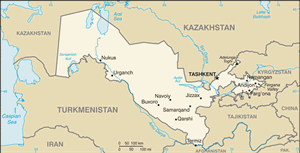The Geography of Uzbekistan
The Geography of Uzbekistan
Uzbekistani Geography
Location: Central Asia, north of Afghanistan
Geographic coordinates: 41 00 N, 64 00 E
Map references: Asia
Area: total: 447,400 sq km land: 425,400 sq km water: 22,000 sq km
Area - comparative: slightly larger than California
Land boundaries: total: 6,221 km border countries: Afghanistan 137 km, Kazakhstan 2,203 km, Kyrgyzstan 1,099 km, Tajikistan 1,161 km, Turkmenistan 1,621 km
Coastline: 0 km (doubly landlocked); note - Uzbekistan includes the southern portion of the Aral Sea with a 420 km shoreline
Maritime claims: none (doubly landlocked)
Climate: mostly midlatitude desert, long, hot summers, mild winters; semiarid grassland in east
Terrain: mostly flat-to-rolling sandy desert with dunes; broad, flat intensely irrigated river valleys along course of Amu Darya, Syr Darya (Sirdaryo), and Zarafshon; Fergana Valley in east surrounded by mountainous Tajikistan and Kyrgyzstan; shrinking Aral Sea in west
Elevation extremes: lowest point: Sariqarnish Kuli -12 m highest point: Adelunga Toghi 4,301 m
Natural resources: natural gas, petroleum, coal, gold, uranium, silver, copper, lead and zinc, tungsten, molybdenum
Land use: arable land: 10.51% permanent crops: 0.76% other: 88.73% (2005)
Irrigated land: 42,810 sq km (2003)
Natural hazards: NA
Environment - current issues: shrinkage of the Aral Sea is resulting in growing concentrations of chemical pesticides and natural salts; these substances are then blown from the increasingly exposed lake bed and contribute to desertification; water pollution from industrial wastes and the heavy use of fertilizers and pesticides is the cause of many human health disorders; increasing soil salination; soil contamination from buried nuclear processing and agricultural chemicals, including DDT
Environment - international agreements: party to: Biodiversity, Climate Change, Climate Change-Kyoto Protocol, Desertification, Endangered Species, Environmental Modification, Hazardous Wastes, Ozone Layer Protection, Wetlands signed, but not ratified: none of the selected agreements
Geography - note: along with Liechtenstein, one of the only two doubly landlocked countries in the world


